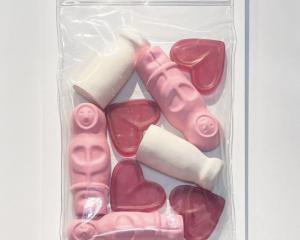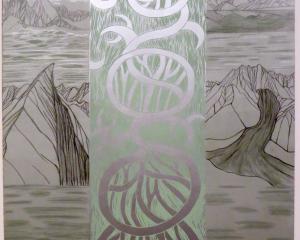Some may consider that this is where the similarities end, as Dunedin artist Kim Pieters' paintings are delicately worked with sparing use of colour and line, while Kirsten Ferguson enjoys a vibrant colour palette using layers of paint.
Some of Pieters' work is based on a series called October Meditations. Worked from drawings and done in a monotone palette of delicate green watercolour paint, these works evoke a feeling of a new spring. Other work displayed is brighter.
Two large pieces show an intriguing depth in their take on a theme inspired by the poem, "The Desert Homeric", by Sally Ann McIntyre. Colour provides a joyous highlight to a sombre narrative.
Worked on grey ragged-edged building boards, much of it is left blank; it is clear Pieters relies on the use of space as much as line in constructing forms.
Ferguson also uses a spring theme on which to base her work. September One consists of layers of paint and vertical lines, hinting at an explosion of spring blossom and trees. The paint is thick and sculptural and the works burst with vitality.
The seventh artist in residence is Anet Neutze, who began her work with no preconceived ideas, enjoying the freedom to play.
This artist's work has evolved by using the walls of the gallery to their full benefit. The abstract work, painted directly on to the gallery walls, catches the eye by creating a sense of scale in a limited colour palette of greens, blacks, and whites, reminding one of being in lush bush. Parts of the work have been allowed to drip naturally down the walls evoking a sense of movement and spontaneity, while other areas are given a thin wash of white paint, providing a more subdued, ethereal experience - as if one's head were in the clouds.
Neutze has used old acrylic house paint to create a work of minimal structure. The image is a product of layers of paint on a flat surface, giving substance and reality to large organic-shaped patches and drips of colour.
A striking aspect of this exhibition is the diversity of subjects and styles, and the range of media. The more unusual include Dugal Armour's sculpture Marigolds, in which a plastic flower arrangement is attached to a turning spoolwinder and plinth, a quirky response to a haiku. Wearable arts also respond, with Autumn Leaf Dress, as does ceramics and jewellery.
Paintings fill the gallery with abstract works and representational pieces. Those on display are largely landscape-based and in media including pencil, ink and woodcut. Native flora and fauna, birdlife, mountains and streams make an appearance as does the mood of the weather, evident in Janet de Wagt's Unexpected Rain.
This exhibition provides a charming escape for its audience, while emphasising the importance of identity and place in the creative mind for both poet and artist.







![Untitled (c. mid 1990s, [pink 3]), by Martin Thompson, 415mm×590mm. Photo: courtesy of Brett...](https://www.odt.co.nz/sites/default/files/styles/odt_landscape_small_related_stories/public/story/2024/02/untitled_pink_3.jpg?itok=Q0aQrc9o)




